A Late Summer and Wader Tour today. It was good birding weather – not too hot, some nice high cloud this morning but getting sunnier this afternoon. August is a great time of year for seeing waders, so that was one of our main targets today. We managed 20 different species today, and saw a very good selection of other birds as well.
Our first stop was at Titchwell. As we arrived early today, before it got too busy, we had a quick look around the overflow car park. The berries and apples are all developing nicely, and we found several Blackcaps already taking advantage of the growing bounty. There were a few Goldfinches and Greenfinches in the bushes too.
The former grazing meadow ‘pool’ is baked very dry now. There is not much to see there as a consequence, a couple of Lapwings today, but it is always worth a quick look. As we arrived, three Collared Doves flew over heading west, and then a Stock Dove dropped down with the Woodpigeons, giving a nice comparison through the scope.
A scan of the saltmarsh revealed four distant Spoonbills. We could just make out their heads as they came up out of the long grass from time to time, before they decided to fly off towards Thornham. We watched a dark chocolate juvenile Marsh Harrier circling over the reeds and as it drifted out over the saltmarsh it started to flush everything hiding out there. Lots of waders, Black-tailed Godwits, Redshanks and Curlews, appeared. Then the Spoonbills flew back in towards the reserve, giving us great views as they came over the path in front of us.
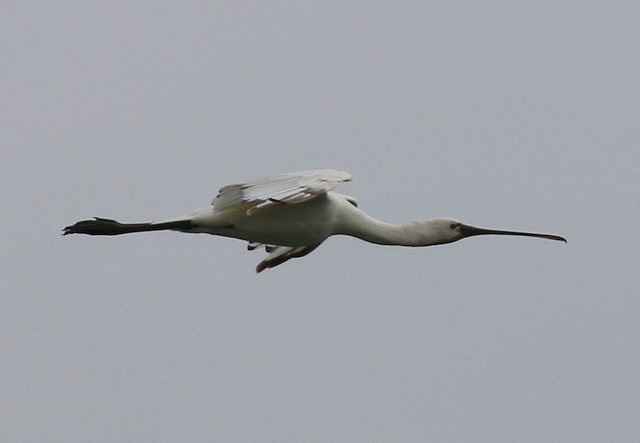 Spoonbill – flew in from the saltmarsh
Spoonbill – flew in from the saltmarsh
There was a nice selection of wildfowl out on the reedbed pool – Gadwall, Shoveler, Teal, Tufted Duck and Common Pochard. The ducks are not at their prettiest right now, with the drakes all in dull eclipse plumage. A single Little Grebe was busy diving right at the back.
A couple of Bearded Tits were calling from the reeds as we walked up to Island Hide. We stopped to scan and had some quick flight views at first, as they zipped across the reebed. Then we managed to find a single juvenile Bearded Tit climbing through some bulrushes. It dropped down into the reeds below to preen, where we could just see it through the scope as the breeze moved the vegetation in front. Then it disappeared down out of view.
There were lots of waders out on the freshmarsh from Island Hide. There is still a very good number of Avocets on here and we watched a couple feeding in front of the hide, sweeping their bills side to side through the shallows. They are aggressive parents and a couple were still chasing off any other waders from the best bits of mud. Including a couple of very obliging Ruff.
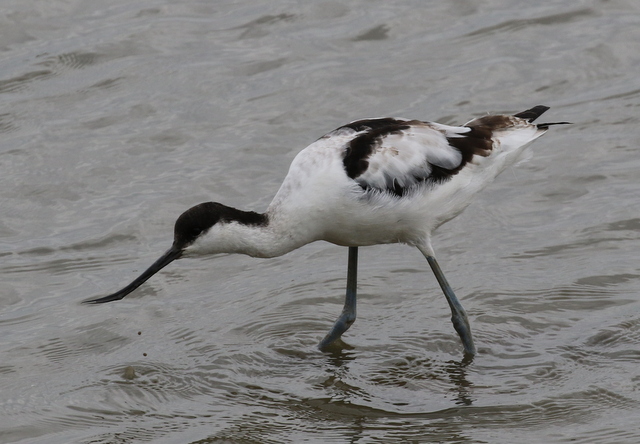 Avocet – this one a young bird with some brown feathers above
Avocet – this one a young bird with some brown feathers above
There are plenty of Black-tailed Godwits here too. Most of them were roosting on one of the low islands over by Parrinder Hide today, with a few more feeding over towards the back. A small group of Bar-tailed Godwits dropped in, probably flushed from the beach. One of them was still mostly in summer plumage, bright rusty underparts extending right down under the tail.
A Common Sandpiper was picking around furtively on the mud over by the reeds. A single winter plumage Spotted Redshank was unhelpfully asleep. Five Golden Plover were running around on one of the grassy islands further over, also still sporting the smart black faces and bellies of summer plumage. The highlight from here was the Little Stint, which we picked up in with a group of Dunlin, white faced and much smaller than its companions.
There was no shortage of Common Terns on the freshmarsh again, a mixture of adults and juveniles. There were fewer gulls than of late, but a scan through revealed a single adult Yellow-legged Gull, conveniently close to a Lesser Black-backed Gull for comparison, the former with a much paler, greyer back.
 Common Tern – an adult just starting to moult its black cap
Common Tern – an adult just starting to moult its black cap
We could hear Bearded Tits calling all the time we were in Island Hide, but they wouldn’t show themselves today. From up on the main path, as we walked further along, there were more Bearded Tits calling from the reeds just below us. We stopped to see if they might appear but they were tucked down on the edge out of view. Very frustrating! We did see several Reed Warblers, a Sedge Warbler and a few Reed Buntings fly in and out. A bright Willow Warbler which dropped into the vegetation by the reeds briefly was more of a surprise here.
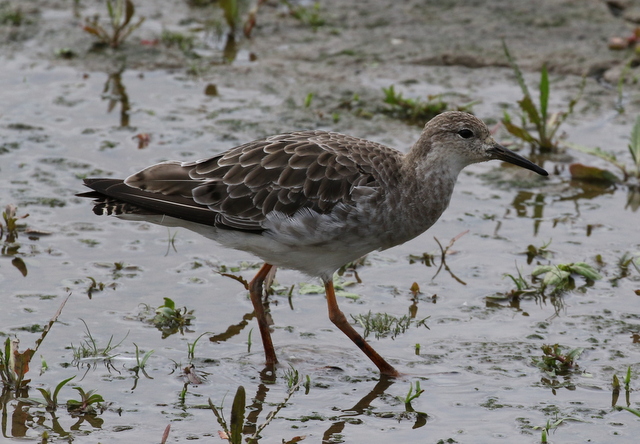 Ruff – a male mostly moulted to winter plumage
Ruff – a male mostly moulted to winter plumage
While we were standing here, we were treated to some closer views of some of the waders. Several Ruff included a couple of browner juveniles and a smaller adult female (a Reeve) still with unmoulted darker summer upperparts. The variety of plumage in different Ruff can be bewildering at times! A few streaky-bellied juvenile Dunlin were picking around on the mud below us and in with them we were treated to lovely close views of the juvenile Little Stint.
 Little Stint – this juvenile showed really well from the main path
Little Stint – this juvenile showed really well from the main path
Scanning the freshmarsh from here, we realised there was a second Little Stint further over. We could hear the distinctive call of a Spotted Redshank and a dusky juvenile dropped in briefly before flying off west, calling all the way. Round at the Parrinder Hide, we could see the large flock of Black-tailed Godwit and a good number of Oystercatcher roosting here too now. A party of Turnstones dropped in, disappearing quickly in amongst the Black-tailed Godwits.
We had seen one Spoonbill well from Island Hide, a lone bird out on the freshmarsh. It was doing what Spoonbills like to do at first, sleeping! However, it woke up for a preen, showing off the yellow tip to its long, black, spoon-shaped bill, which identified it as an adult. From Parrinder Hide we could see that there were actually lots of Spoonbills on here today, and the rest of them were all hiding round the back of the islands. We counted at least 19 that we could see, including the one out in full view.
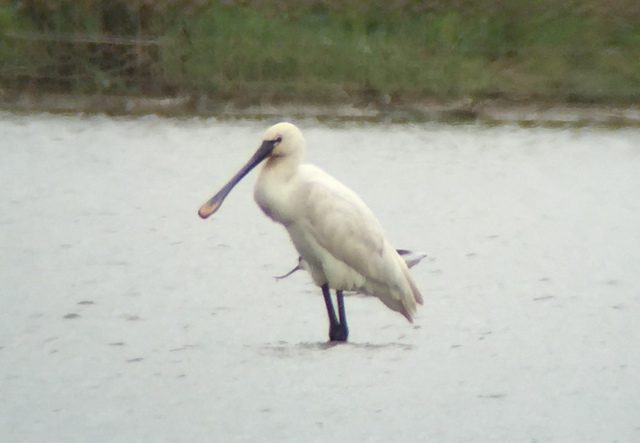 Spoonbill – an adult, with yellow-tipped bill
Spoonbill – an adult, with yellow-tipped bill
We heard a couple of Yellow Wagtails flying over while we were up on the main path, and we had a request to see one. Parrinder Hide is normally a good place to see them, but we had to content ourselves with a few Meadow Pipits and a flock of Linnets at first, including a very smart male which flew in for a drink. Eventually the Yellow Wagtails gave themselves up, and three perched up on the fence for us to see.
The Volunteer Marsh is rather dry at the moment, but a very showy Little Egret was fishing just below the path. There were lots of Common Redshank in the tidal channel. Two Grey Plover were right down towards the back, with one starting to moult out of summer plumage, with black belly but brown and white spotted face, but the other already in winter plumage lacking any black below.
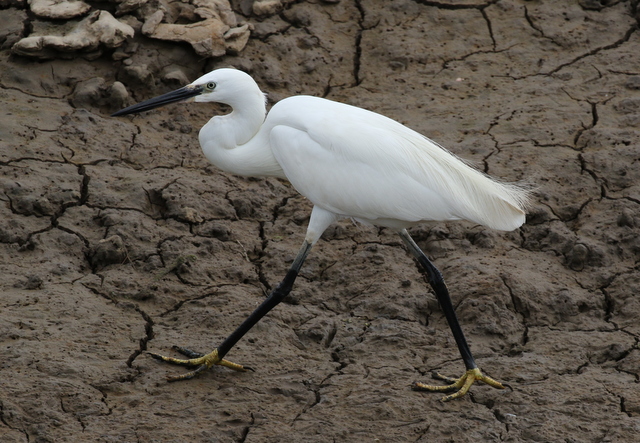 Little Egret – flashing its yellow feet
Little Egret – flashing its yellow feet
Out at the beach, we had a quick scan of the sea. A raft of Common Scoter were swimming and diving offshore. A distant Gannet flew east and a few terns were fishing. Then it was time to make our way back. A Whimbrel called out over the saltmarsh and we could see it circle round in the distance. Fortunately, when we got back to the freshmarsh, another Whimbrel had dropped in and was standing out on the mud so we could get a much better look at it.
The Bearded Tits by the main path were still calling and still hiding, but we had a bit more luck back near Island Hide. We stood and waited a while and one flew in, landing in the tops of the reeds briefly before dropping down to the mud below. A second Bearded Tit flew in to join it, but even here they were hard to see, with tall reeds in front and the birds creeping around in among the reed bases. With a bit of patience, everyone got to see them and then it was back for lunch.
The rest of the afternoon was spent at Snettisham. The tide was not going to be high enough to get all the waders in close today, but as we arrived we could see the huge flocks of birds swirling out over the edge of the water. Quite a spectacle, even if they were not going to be forced off the Wash. We spent a while admiring the different shapes of the flocks. Stunning stuff!
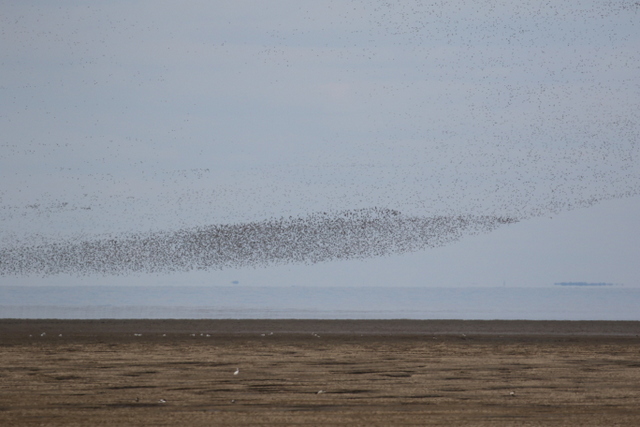
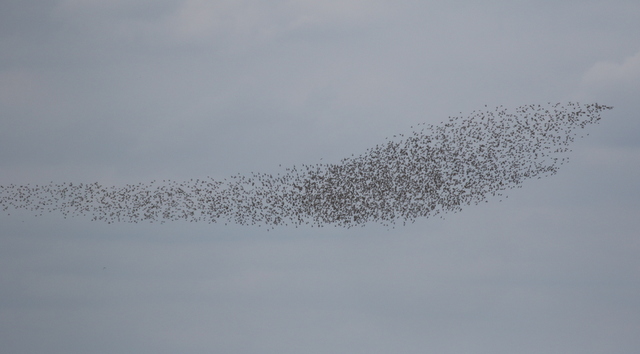 Wader flocks – mostly Knot, out over the Wash
Wader flocks – mostly Knot, out over the Wash
There are probably around 60,000 birds here at the moment, of which the largest number are Knot. We could see some huge flocks of Curlew and Oystercatcher, standing around on the drier mud . Most of the other birds were rather distant, with added heat hazee now the sun was out, though we did find a number of Ringed Plovers closer to us, an addition to the day’s list.
We made our way down to Shore Hide. There were a few butterflies out in the sun in the short grass, including several Common Blues and a smart Wall. A Six-spot Burnet moth posed nicely on some Viper’s Bugloss.
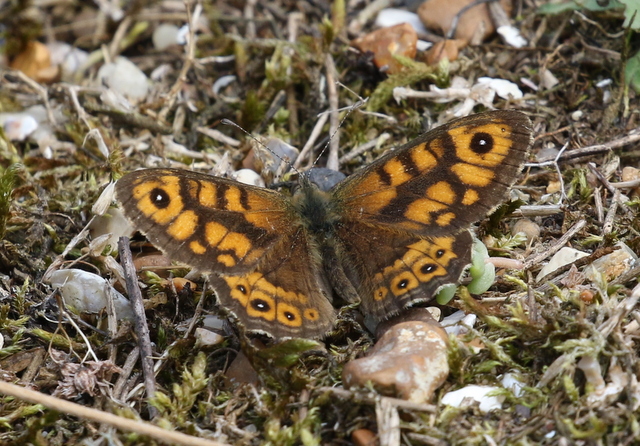 Wall Brown – enjoying the afternoon sun
Wall Brown – enjoying the afternoon sun
From the hide, there were lots of Cormorants on the islands, panting in the afternoon sun. There is no shortage of geese here, with lots of noisy Greylags, a good number of Egyptian Geese and even three feral Barnacle Geese today.
Despite the fact that the tide was not high enough to force all the waders off the Wash today, there were still a few birds roosting on the pit. Hiding in amongst the geese, we found a party of eight Spotted Redshanks. We got a better view of them here than at Titchwell – most were already in winter plumage, but two of them were still heavily speckled with black below. There were also a good number of Greenshank sleeping on the gravel islands.
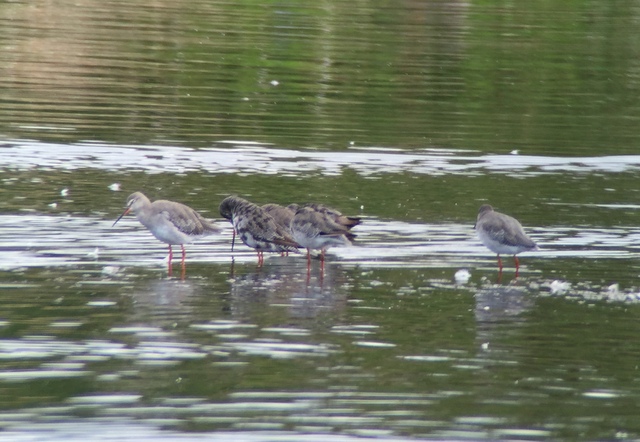 Spotted Redshanks – at least 8 here today
Spotted Redshanks – at least 8 here today
The wader we had really come to see took a bit more searching. We eventually found the Red-necked Phalarope at the back of the pit, tucked in below the shingle on the far side opposite the hide. It was a juvenile, with dark back, white underneath and sporting a distinctive black mask. However the most distinctive thing about the phalaropes is how they like to feed, swimming on the water, picking at the surface for insects. We watched as they Red-necked Phalarope swam up and down below the bank.
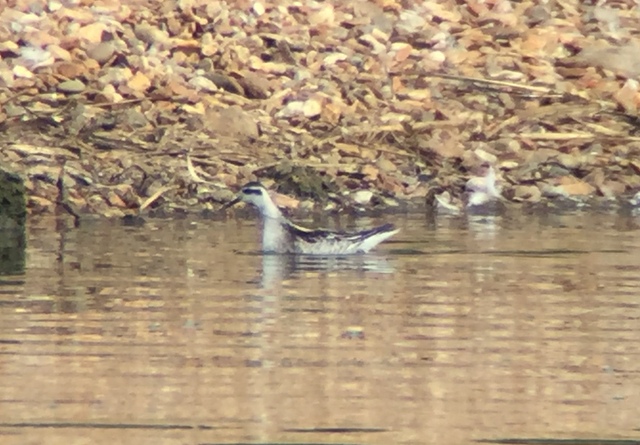 Red-necked Phalarope – this juvenile was still at Snettisham today
Red-necked Phalarope – this juvenile was still at Snettisham today
It was not all about the waders. A Lesser Whitethroat appeared briefly in the bushes in front of the hide, before flying back along the bank. Later we found at least two Lesser Whitethroats in the bushes close to Rotary Hide. One was feeding on berries in the elder bushes right in front of the hide. It chased off another bird that came near, which turned out to be a Common Whitethroat and the two birds perched side by side at one point, giving us a nice comparison.
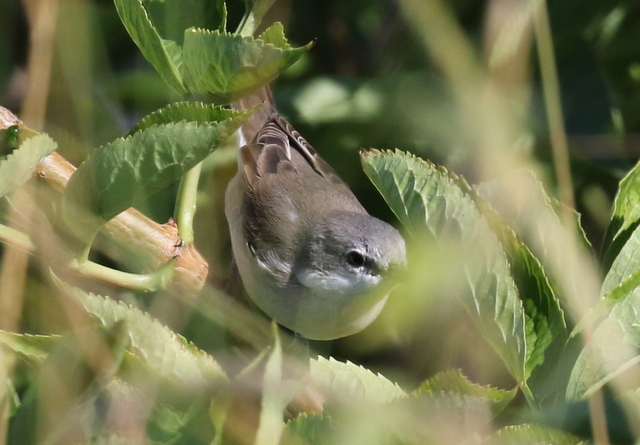 Lesser Whitethroat – lurking in an elder bush
Lesser Whitethroat – lurking in an elder bush
The largest number of waders on the pit today were Black-tailed Godwits, a massive flock roosting on one of the islands towards the north end of the pit. Viewing from Rotary Hide, we got a better view of the small number of Knot which were roosting in with them.
From the other side of the hide, we could still see the vast flocks of waders swirling around over the Wash. They seemed to be a bit more settled now, with the tide going slack over high tide and not pushing them any further up towards us. Still, it was great to watch them as we walked back, a great way to finish the day.
















